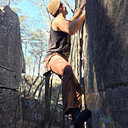The Second Heart
The Role of The Skeletal Muscle Pump In Maximal Endurance Performance
If an aeronautical engineer where to analyze a bumblebee they would quickly occlude that it could never fly. Yet, it does. Similarly, if a hydrodynamic analysis were done on the human circulatory system it would lead to the conclusion that human beings cannot stand upright, Yet, they do. We partly owe this ability to our ‘second heart’.
While the heart acts as the ‘master pump’ in our bodies, it could not function without a secondary pump, called the ‘muscle pump’. The muscle pump acts as a secondary heart on the venous (return) side of circulation. Without this second heart an exercising human could not force enough blood back to the right ventricle of the heart to maintain an adequate level of cardiac output to keep them upright, and conscious, let alone exercising.
If you’ve ever stood up for an extended period of time, without the slightest movement, you’re familiar with the sensation of teetering on the bring of unconsciousness. Thankfully, even the most modest muscle contractions of the leg muscles are enough to act as an effective pump driving blood back to the heart and preventing you from blacking out. The reason for this is that these muscles contract rapidly to restore ventricular filling pressures and stroke volume.
However, when this muscle pump becomes ineffective, black out can ensue with the flip of a switch. Ultra-Marathoners are all to familiar with this. It’s not uncommon for an ultra runner, deep into a hundred miler, to be running strong, but the second they stop moving they go light outs and hit the deck. The reason for this is that the sustained demand for oxygen supply leads to extreme vasodilation in the lower limbs, and in order to maintain this level of vasodilation (and arterial blood pressure) without exceeding the maximum pumping capacity of the heart there needs to be a given level of sympathetic input and muscle tension present. When these athletes stop running too much pressure is taken off the lower limbs (because the muscles are no longer contracting and have too low a resting level of tension) and their cardiac output begins to decrease as well, which causes a hypotensive event (leading to a loss of consciousness).
One way to combat this is to increase the maximal pumping capacity of the heart, which is an unlikely and impractical solution in this case. Another is to improve muscle strength, particularly the muscles in the lower legs. While this isn’t ‘sport specific’ training for an ultra-marathoner, it can make a meaningful difference in their cardiovascular control late into an event, and as a result it can drastically improve performance.
While I have no desire to compete in ultras, I do find the sport interesting as a physiologist. Exercise more than any other stress taxes the regulatory ability of the cardiovascular system. The advantage of studying athletes on the fringes of human performance is that we can learn more about how a system operates by pushing it to it’s limit than when it’s idle.
